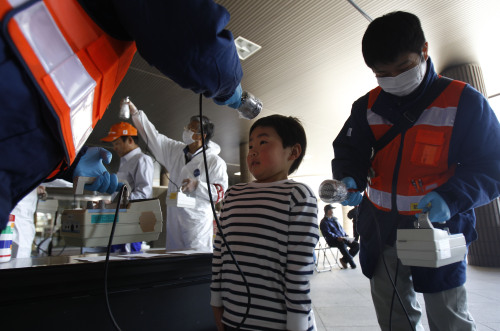Contamination 10,000 times higher than the government standard for nuclear plants
TOKYO (AP) ― Radiation exceeding government safety limits has seeped into groundwater under a tsunami-crippled Japanese nuclear plant, according to the operator, but has not affected drinking supplies.
The leak announced late Thursday could pose a long-term problem, however, and at the very least it is a concerning indicator of how far Tokyo Electric Power Co. is from bringing its plant under control. Workers have been battling to stabilize dangerously overheating reactors after cooling systems were knocked out in the March 11 tsunami.
TEPCO has increasingly asked for international help in its uphill battle, most recently ordering giant pumps from the U.S. that were to arrive later this month to spray water on the reactors.
The groundwater contamination ― 10,000 times higher than the government standard for the plant ― is the latest setback at the Fukushima Daiichi complex, where leaks have already contaminated food and hindered workers’ ability to bring the plant under control.
Iodine-131, a radioactive substance that decays quickly, was found nearly 15 meters below one of the reactors, according to TEPCO spokesman Naoyuki Matsumo.
While the contamination does not appear to have caused an immediate problem, there are two ways it could eventually affect drinking water if concentrations were high enough. One is if it were to seep into wells in the area. For now, a 20-kilometer radius around the plant has been cleared, though residents of the area are growing increasingly frustrated with evacuation orders and have been sneaking back to check on their homes.
The other concern is whether contaminated water from the plant could seep into underground waterways and eventually into rivers used for drinking water. It’s not yet clear if this is possible.
Seiki Kawagoe, an environmental science professor at Tohoku University, also noted that radiation tends to dissipate quickly in the ground, as it does in the ocean.
 |
A young boy is screened for radiation contamination before entering an evacuation center in Fukushima, Japan, Friday. (AP-Yonhap News) |
Radiation concerns have rattled the Japanese public, already struggling to return to normal life after the earthquake-borne tsunami pulverized hundreds of kilometers of the northeastern coast. Three weeks after the disaster in one of the most connected countries in the world, 260,000 households still do no have running water and 170,000 do not have electricity.
In the latest report of food becoming tainted, the government said Friday that it planned more tests on a cow slaughtered for beef that had slightly elevated levels of cesium, another radioactive particle. Officials stressed that the meat was never put on the market.
Health Ministry spokesman Taku Ohara said the cesium was found in a cow slaughtered March 15 more than 70 kilometers from the plant.
Radioactive cesium can build up in the body and high levels are thought to be a risk for various cancers. It is still found in the soil of Germany, Austria and France 25 years after the Chernobyl nuclear disaster and is found in wild boar in Germany, making the pigs off-limits for eating in many cases.
Contamination has also affected work at the plant itself, where radioactive water has been pooling, often thwarting the vital work of powering up the complex’s cooling systems.
Despite the leaks, TEPCO hasn’t had enough dosimeters to provide one for each employee since many were destroyed in the earthquake.
Under normal circumstances, the gauges, which measure radiation, would be worn at all times. But officials said Friday that more meters had arrived and they now had enough to everyone.
TEPCO has repeatedly relaxed safety standards during the crisis in order to prevent frequent violations. That is not uncommon during emergencies.
Though the company has acknowledged that it was initially slow to ask for help in dealing with the nuclear crisis, experts from around the world are now flooding in. French nuclear giant Areva, which supplied fuel to the plant, is helping figure out how to dispose of contaminated water and American nuclear experts are joining Japanese on a panel to address the disaster.
Japan has also ordered two giant pumps, typically used for spraying concrete, from the U.S. They are being retrofitted to spray water first, according to Kelly Blickle, a spokeswoman at Putzmeister America Inc. in Wisconsin. At least one similar pump is already in operation at the plant.
U.S. troops are also involved in the search for the dead. Japan’s defense ministry said, starting Friday, the two militaries will create joint teams to look for bodies from the air. So far 11,500 people have been confirmed dead, though that figure it expected to exceed 18,000. Another 16,400 are missing, and many may never be found.







![[Today’s K-pop] Blackpink’s Jennie, Lisa invited to Coachella as solo acts](http://res.heraldm.com/phpwas/restmb_idxmake.php?idx=644&simg=/content/image/2024/11/21/20241121050099_0.jpg)
